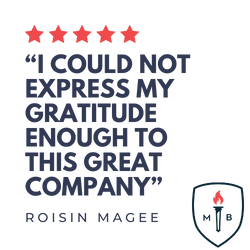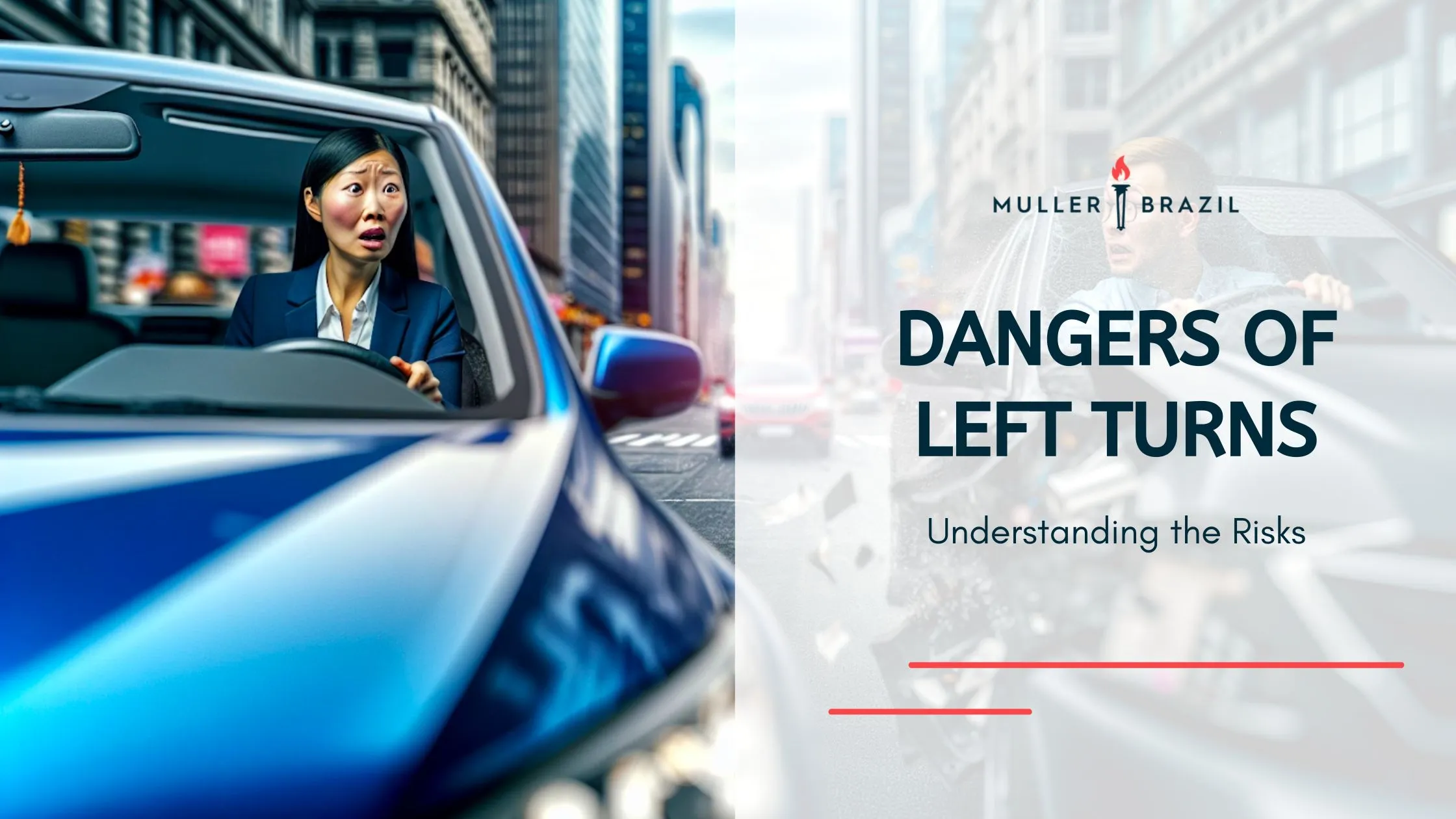8 min read
Dangerous Left Turns | Risks, Causes, and Safer Driving Strategies
![]() Maximillian J. Muller, Esquire
Feb 17, 2024 2:53:37 PM
Maximillian J. Muller, Esquire
Feb 17, 2024 2:53:37 PM
Left-turn accidents are a leading cause of road injuries, making it necessary for drivers to understand the dangers of left turns and how to avoid left-turn collisions. These maneuvers often involve complex decisions, such as judging oncoming traffic speed and dealing with visibility challenges. By recognizing the risks and implementing safer driving practices, you can minimize the chances of a left-turn-related collision.
Did you know that approximately 22% of motor vehicle collisions in the US are associated with left-hand turns? Those accidents lead to severe injuries or even fatalities.
In this blog post, we will discuss the risks and dangers of a left hand turn accident, factors contributing to these accidents, legal implications, and strategies for safer left turns. We will also explore real-world examples and interactive elements to help you better understand “what makes a left turn across traffic dangerous” and avoid left-turn dangers.
The Perils of Left-Turn Accidents
Left-turn accidents are among the most dangerous maneuvers on the road, with the U.S. Department of Transportation National Highway Traffic Safety Administration (NHTSA) reporting that they pose the highest risk. A staggering 60% of collisions at a particular intersection were attributed to left-hand turns. Avoiding a left hand turn crash often involves crossing oncoming traffic, judging the speed of other vehicles accurately, and navigating blind spots and visibility issues.
To make a left turn safely, drivers must be aware of multiple potential threats, such as other vehicles, traffic lights, and blind spots. Failure to address these challenges can lead to T-bone crashes and serious injuries or fatalities.
Crossing Oncoming Traffic
Crossing oncoming traffic is one of the most significant challenges of making a left turn. Misjudging the speed and distance of oncoming vehicles, failure to yield the right of way, and disobeying traffic signals lead to car accidents. Collisions that frequently occur during left turns include T-bone accidents and head-on collisions.
Factors that impair a driver's judgment when making a left turn across oncoming traffic include:
- Misjudging the speed and distance of oncoming vehicles
- Failing to assess gaps in traffic accurately
- Being distracted or not paying full attention to the road
- Making assumptions about the intentions of other drivers
- Feeling rushed or pressured to make the turn quickly
Judging Speed Correctly
Accurate assessment of the speed of oncoming vehicles plays a key role in executing safe left turns. Misjudging the speed of an oncoming vehicle can result in a T-bone accident. These accidents, also known as side impact or broadside collisions, are highly dangerous and can result in serious injuries or even death.
Drivers can use visual cues to accurately assess the speed of approaching traffic. Cues include taking note of the dashes and spaces that divide the lanes on a paved roadway and paying attention to the spontaneous gaze behavior of oncoming vehicles.
Blind Spots and Visibility
Blind spots and poor visibility make left turns more dangerous. Blind spots refer to the areas that cannot be seen by the driver's field of vision or through the mirrors. These areas are outside the driver's line of sight and are hazardous when changing lanes or making turns.
Blind spots may obstruct a driver's view of oncoming traffic from the left side, potentially resulting in the driver misjudging the speed and distance of approaching vehicles, and thus may lead to a collision when making a left turn.
Factors contributing to poor visibility while driving include reduced visibility conditions such as twilight, darkness, rain, snow, fog, smoke, bright sunshine, and environmental factors like fog, which can occur in the morning or before rainfall.
Poor visibility impedes left turns by reducing the driver's ability to observe oncoming traffic. This makes it challenging to accurately gauge the speed and distance of approaching vehicles and raises the risk of a collision.
Factors Contributing to Left-Turn Accidents
Several factors contribute to left-turn accidents, including distracted driving, night driving, and high traffic levels.
Distracted Driving
Distracted driving is a significant factor contributing to left-turn accidents. Common distractions leading to left-turn accidents include:
- Texting or using a smartphone
- Talking on the phone
- Changing the audio or music
- Managing children or pets in the vehicle
Approximately 22% of all car accidents involve a left-turning vehicle, and 53% of all cross-path accidents result from left turns.
Research has demonstrated a correlation between distracted driving and decreased safety, as well as increased driver reaction times to unexpected risks on the road. By minimizing distractions and focusing on the road, drivers significantly reduce the risk of left-turn accidents.
Night Driving
Night driving makes left turns more dangerous due to reduced visibility and increased difficulty in judging distances and speeds. Reduced visibility at night leads to an increased risk of left-turn accidents, as it is difficult to recognize conditions on the road, and the need for focus from the drivers is heightened.
Judging distances and speeds during night driving is more difficult due to the lack of visual cues and reduced visibility. Without adequate lighting, it is harder to accurately perceive distance and judge the position and speed of other vehicles.
Fatigue and drowsiness, more common during nighttime driving, affect the driver's alertness and reaction time. Tiredness potentially results in poor decision-making when making left turns. Discover how you can stay safe on the road with our expert tips for preventing drowsy driving.
Heavy Traffic
Heavy traffic makes left turns more challenging, as drivers must use multiple lanes and vehicles while making their turn. In heavy traffic, left-turn accidents occur due to a variety of reasons. Driver impatience and errors arise from the frustration and challenge of turning left. Furthermore, left turns involve entering blind spots, thus increasing the risk of collisions.
In heavy traffic, a driver's judgment in making a left turn is impacted in various ways. Some factors that affect a driver's judgment include:
- The number of vehicles makes it challenging to identify a safe gap in oncoming traffic to make the turn
- The pressure of other drivers behind leads to hasty decisions and misjudgments
- The stress and frustration caused by heavy traffic diminishes a driver's focus and decision-making abilities
Drivers need to remain calm and focused in heavy traffic situations to be safe and pull off accurate left turns.
Read more about the most common causes of car accidents.
Legal Implications of Left-Turn Accidents
When it comes to left-turn accidents, determining fault often depends on traffic laws and driver behavior. Legal cases involving the dangers of left turns typically require proof that the driver failed to yield or misjudged oncoming traffic. Consulting an experienced attorney can help victims navigate these challenges and pursue compensation for left-turn collision damages.
Determining Fault
In left-turn accidents, fault is typically determined by a few factors, such as traffic signals, speed, and driver behavior. Police officers at the scene will usually file police reports to establish fault.
Furthermore, the laws stipulate that drivers making left turns must yield to oncoming cars. Thus the at-fault driver is often the left-turning driver. An experienced car accident attorney also helps verify fault by examining traffic laws and conducting an independent investigation.
Traffic signals, the right of way, the speed of the vehicles, and other traffic violations may be considered when assigning fault in left-turn accidents. Driving at or above the speed limit or at an unsafe speed while making a left turn increases the chances of causing an accident and may be considered when assigning fault.
Compensation for Victims
Victims of left-turn accidents may be eligible to pursue compensation for damages, including:
- Medical bills
- Lost income
- Pain and suffering
- Other associated expenses
The at-fault party's insurance company may also consider other elements, such as the driver's negligence and any applicable laws or regulations. It is advisable to consult with personal injury lawyers, specifically a Philadelphia car accident attorney, to gain insight into the specific factors that may affect compensation in your case.
Following a left-turn accident, the procedure for requesting remuneration generally requires:
- Collecting evidence
- Informing the insurance company
- Obtaining medical care
- Consulting with a lawyer
- Bargaining a settlement
- Initiating a lawsuit if necessary.
In many left-turn accidents, the insurance company of the left-turning driver is often found to be primarily responsible for the car accident. The insurance company will provide compensation to the victims for their losses.
Strategies for Safer Left Turns
Defensive driving and respecting traffic laws and signals are key to guaranteeing safer left turns. We will elaborate on specific defensive driving techniques and discuss how traffic laws and signals contribute to safer left turns.
Defensive Driving
Defensive driving is a set of skills and techniques that help drivers to anticipate and avoid potential hazards on the road. By exercising defensive driving, drivers are more cautious and attentive when making left turns, thus decreasing the likelihood of collisions with oncoming traffic or pedestrians. Some specific defensive driving techniques to use during left turns include:
- Avoiding non-signaled left turn options and ‘permitted phase' lights
- Using right turn loops by pre-planning your route
- Performing shoulder checks to the left to make sure it is safe to perform the turn
- Glancing left first to make sure all traffic is stopping before entering the intersection
Maintaining a safe distance helps to reduce the risk of rear-end collisions and thus prevent left-turn accidents. By maintaining the necessary distance from the vehicle in front, you can respond quickly and stop if the vehicle ahead suddenly stops or slows down, thereby avoiding a collision. Awareness of one's environment allows for anticipation and response to potential hazards, thus reducing left-turn collisions.
Traffic Laws and Signals
Traffic laws and signals contribute to left turn safety by establishing clear guidelines and instructions for drivers. When making a left turn at a controlled intersection, drivers should:
- Yield to oncoming traffic
- Wait for a green arrow signal indication, which indicates a dedicated left-turn phase
- Turn left while oncoming traffic is stopped
The green arrow signal, acting as a stop sign for conflicting traffic from the opposite direction, makes sure that there is no interference, thereby reducing the risk of accidents during left turns.
Yielding to oncoming traffic, implementing left-turn traffic signals, increasing visibility and light, and improving intersection design are ways traffic laws and signals help establish safer left turns.
Summary
Understanding the dangers of left turns is critical to reducing the high accident rates associated with these risky maneuvers. By learning how to avoid left-turn collisions through defensive driving and adherence to traffic laws, drivers can make safer choices on the road. Whether you’re recovering from a left-turn accident or seeking preventative tips, making informed decisions is key to staying safe.
At Muller Brazil, we specialize in helping victims of left-turn accidents secure the compensation and justice they deserve. If you or a loved one has been affected by a left-turn collision, don’t navigate the aftermath alone.
Contact us today for a free consultation and let our experienced team guide you through your legal options. Together, we can help you move forward with confidence. Visit Muller Brazil now to learn more!
Frequently Asked Questions
Why are left-turn car accidents so common?
Left-turn car accidents are prevalent because they require drivers to judge the speed and distance of oncoming traffic accurately while navigating blind spots and potential distractions. These factors make left turns one of the most dangerous maneuvers at intersections. Defensive driving and adherence to traffic laws can significantly reduce the risk.
What makes busy intersections particularly dangerous for left turns?
Busy intersections increase the risk of left-turn accidents due to high traffic volumes, multiple lanes to navigate, and driver impatience. These conditions often lead to misjudgments or rushed decisions, making it vital to stay focused and wait for clear gaps in traffic before turning.
What are the facts about left turns?
Left turns are one of drivers' most dangerous maneuvers and account for roughly 25% of all car accidents. Driver error is often to blame in left turn accidents, which have high crash rates for older drivers. It is important to be aware of the different types of left-turn situations and to always yield to oncoming traffic when making a left turn.
What is the risk when you cut the corner during a left turn?
Cutting the corner during a left turn is dangerous and can lead to a sudden crash with another vehicle.
How do you know if it's an unprotected left turn?
An unprotected left turn occurs when a driver lacks the right-of-way to make the turn and must yield to oncoming traffic. This maneuver typically happens without the assistance of a red light or stop sign, and drivers must look for vehicles coming from the opposite direction before proceeding across the intersection.
What are the most common causes of left-turn accidents?
Left-turn accidents are commonly caused by misjudging oncoming traffic speed, navigating blind spots, and visibility issues.
Meet the Author
Max Muller - Founding Partner
Maximillian J. Muller is a founding member of Muller Brazil and My Vaccine Lawyer. Mr. Muller is an experienced litigator in both Federal and State Courts in the areas of vaccine injury, unsafe drug and medical device injury, personal injury, mass torts, and bad faith. Mr. Muller prides himself on keeping Muller Brazil on the cutting edge of injury litigation and running a client-focused practice.
Learn more about Max Muller ⇒





